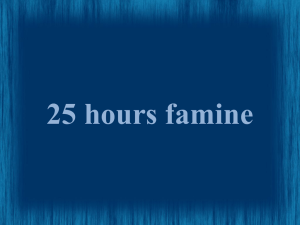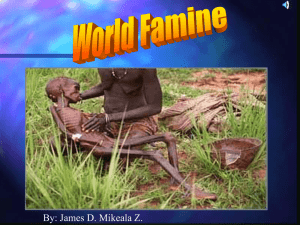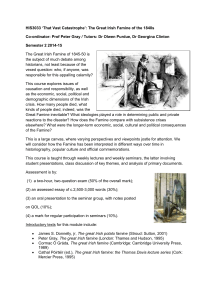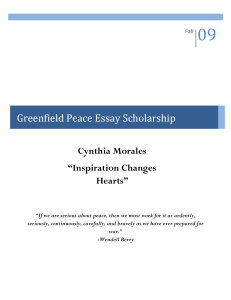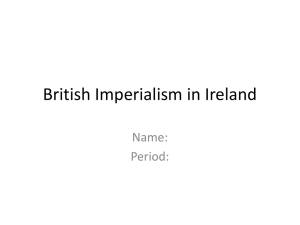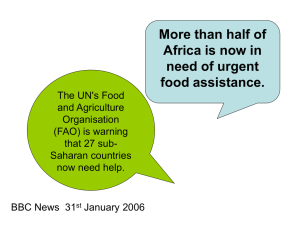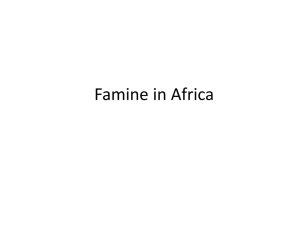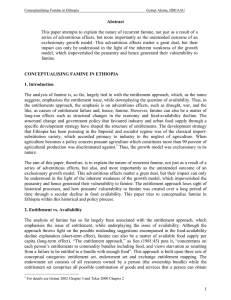Spring term 2014 topic 5 Ethiopia celebrity
advertisement
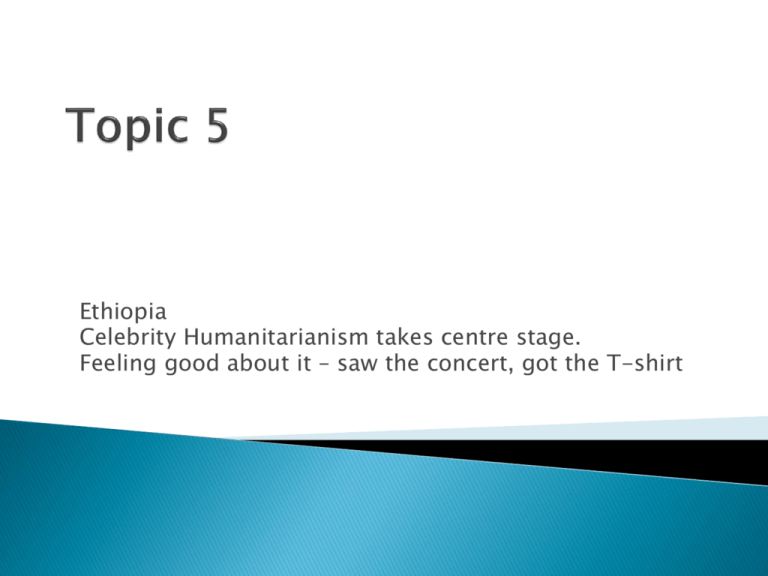
Ethiopia Celebrity Humanitarianism takes centre stage. Feeling good about it – saw the concert, got the T-shirt Surveys of the history of Ethiopia – notably by Richard Pankhurst – show that there have been references to famine in Ethiopian recorded history since the 15th Century. Famines are recorded as occurring about once every decade between 15th and 19th Century. Ethiopia’s north (Tigre, Wollo and, until its independence, Eritrea) are arid and have unreliable rainfall patterns. In recent centuries Ethiopia characterised by regular warfare caused by dynastic strugglesand clashes between settled and nomadic or migrating populations. Warfare, the distance between rulers/landowners and the peasantry meant that famine relief was unknown. Drought led to famine through the existence of conflict or neglect A drought started 1969 as dry weather brought disaster to the Sahel region. By 1973 the drought had severely reduced harvests and food stocks. Ethiopian government was blind and deaf to the crisis, leading to famine. By the end of 1973, famine had claimed the lives of about 300,000 peasants of Tigre and Welo, and thousands more had sought relief in Ethiopian towns and villages. Little was done by the imperial government and aid was not requested – until Jonathan Dimbleby’s film created international concern. Dimbleby wrote in 2002: “… I stumbled on a famine which had already claimed upwards of 100,000 lives but which the government had concealed from the outside world. The film… ricocheted around the globe. It was the first 'television' catastrophe of its kind and it soon raised over $150 million - in today's money which triggered a huge international relief operation. A few months later, The Unknown Famine, as we called our report, became a catalyst for the overthrow of the quasi-feudal regime of Haile Selassie. “ November 1973, Selassie finally let food supplies into the famine areas. In the months following admission of famine, and with the growing role of aid agencies in the face of inadequate government action, the imperial system disintegrated . Radical army officers began seizing control of cities, barracks and then major public buildings. They had the support of leftist student groups. The crumbling government attempted reforms but they were not enough and the Derg started arresting politicians and members of the Emperor’s entourage. Posters appeared showing starving peasants next to a picture of Selassie feeding his dogs with chunks of meat. On 11th SeptemberDimbleby’s film was shown on Ethiopian TV, recut to include scenes at the imperial palace and retitled The Hidden Hunger. This was used to devastating effect on Ethiopian television to soften up the Emperor's subjects for the military coup which brought Mengistu to power.” The next day parliament was abolished and Selassie deposed. Revolution ended the old, out of touch imperial system but the revolutionaries at first concentrated on grabbing power and destroying. Land reform was promised but then replaced by forced resettlement and collectivisation. The unpopular and costly war in Eritrea was pursued with more resources. Leftists from Tigre disillusioned with the new regime set up the TPLF and started a new insurgency to overthrow the Derg. It fought on until it overthrew the Derg and Mengistu in 1991. Drought War in Tigre and Eritrea Derg resettlement campaign 10th anniversary of Derg – didn’t want famine to spoil the party Don’t mention the war or politics Aid denied to those who wouldn’t be resettled and some NGOs allowed aid to be used for resettlement programmes Aid siphoned off by government army and militias and by rebels. 80,000-100,000 (figures from De Waal) died during resettlement campaign which he believes matches the numbers saved by aid. Over 600,000 resettled b y coercion or food denial and left destitute in regions to which they were resettled without promised water supplies, homes, power or agricultural support. Aid used as a lure to get villagers in Tigre to go to feeding camps from where they were forcibly resettled or denied food. Resettlement was about the war not ending famine. Buerk report 23 October 1984: http://www.youtube.com/watch?v=mj2jf0US 8zI Geldof on Live Aid day http://www.youtube.com/watch?v=ezzmrxXh 0oQ http://www.youtube.com/watch?v=4EJvizCVEyc B’desh Band Aid 1984 http://www.youtube.com/watch?v=ezzmrxXh0oQ http://www.youtube.com/watch?v=sok9nqK6SrI&feat ure=related Culmination in Live Aid 1985 http://www.youtube.com/watch?v=BlDhd_0f-r4 Has spawned things like Comic Relief and Sport Relief Clooney in Sudan http://www.youtube.com/watch?v=p89OuPODBMM Politics and war downplayed. Aid groups said famine due to drought, environmental decline and overpopulation in arid areas. But drought effects were magnified by army and militia raids in war areas and food denial to those rural areas. Theft of food aid/aid money by army and militias and rebels (Keen, Complex Emergencies pp 103-4). In 2005 a UK Make Poverty History campaign was launched in response to the G8 meeting at Gleneagles, Scotland As part of the campaign, ten concerts took place simultaneously in the G8 countries, and South Africa – Live 8 Organised by Sir Bob Geldof, who organised Live Aid in 1985 Live 8 boasted a global audience of an estimated 3 billion? – half the world’s population (…but which half?) “We don’t want your money. We want your name” Bob Geldof Emphasis on global unity - ‘one day, one concert one world’ (Live 8 promotional literature), demand for debt relief for poorest countries. Constant references to ‘our brothers and sisters in Africa’, the world as a family Brilliant marketing of consumer aid product – aid and advocacy as a lifestyle choice. Been there, done that, seen the video, got the wristband. Damon Albarn's (2005) accused the ethnic makeup of the London show of being "so damn Anglo-Saxon“ and said the event was treating Africa "like it's a failing, ill, sick, tired place“ - same as Live Aid For many relief professionals, media coverage and celebrities have always been crucial. "Ethiopia would not have got the attention it did without Live Aid," says Joanna Macrae, former coordinator of the humanitarian policy group at the Overseas Development Institute. Macrae, however, has reservations about what she has dubbed "quick, loud responses". Every seasoned aid worker knew then that there was no necessary connection between raising money for a good cause and that money being well spent. (David Rieff – Guardian – full piece on Moodle) Chumbawumba’s 1986 record Pictures Of Starving Children Sell Records was critical of the possible motivations of pop stars involved in Live Aid Live Aid billed as ‘saving the world’ yet what changed? (Further famines in Ethiopia 1987/9 –etc Compassion Fatigue) The same criticisms were levelled at participants of Live 8 HMV compiled a Live 8 album boost chart – Pink Floyd album sales = up nearly 1400%, The Who = up nearly 900%, Annie Lennox = 500%...prompted many to suggest that royalties should go to charity, that Live 8 was Geldof’s ‘rock catwalk’…
